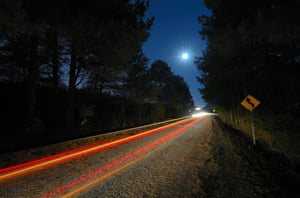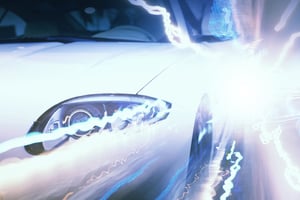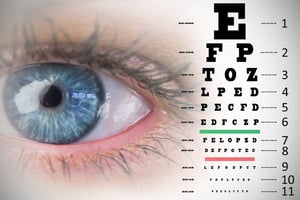 We all have places to be, and we can't afford to let darkness stop us. Whether it's a commute from work to home during the winter when night-time falls earlier, or a trip to visit family when you want to avoid traffic, driving at night is sometimes unavoidable. It is also inherently more dangerous.
We all have places to be, and we can't afford to let darkness stop us. Whether it's a commute from work to home during the winter when night-time falls earlier, or a trip to visit family when you want to avoid traffic, driving at night is sometimes unavoidable. It is also inherently more dangerous.
According to the National Highway Traffic Safety Administration, road fatalities triple at night. This is due to a number of factors, such as drivers' lack of depth perception, peripheral vision impairment, fatigue, and the presence of other impaired drivers. But we are not helpless.
Here are a few simple guidelines you can follow to combat risk while driving at night.
Before You Drive
 Aim Your Headlights: Visibility at night is limited to 500 feet ahead with high beams on, and about 250 feet with normal headlights. This doesn't leave much time for reaction, and misaligned lights can even further decrease the time you have to react to something on the road. Time, age, or frequently changing the headlight bulb, can all lead to misaligned headlights--beams that are aimed either too steeply at the ground or too high into the sight of oncoming traffic.
Aim Your Headlights: Visibility at night is limited to 500 feet ahead with high beams on, and about 250 feet with normal headlights. This doesn't leave much time for reaction, and misaligned lights can even further decrease the time you have to react to something on the road. Time, age, or frequently changing the headlight bulb, can all lead to misaligned headlights--beams that are aimed either too steeply at the ground or too high into the sight of oncoming traffic.
Follow the instructions in your vehicle owner's manual or in this Guide when adjusting your headlights, or take the vehicle into a shop and have a professional adjust them for you. Even when your headlights are aimed correctly, grime and dirt can distort their projection, so make sure to clean them often. It is recommended that you purchase a headlight polish kit to remove any haze, and replace old bulbs when they start to go dim.
Dim Your Dash: Nowadays, with large screens and bright dashboard LED's making their way into new vehicles, there can be many sources of distraction for your eyes when driving at night. It is important that you remember to hit the dashboard dimmer switch, which removes reflection on the windshield and allows your eyes to better adjust to the darkness ahead.
Clean The Windshield: A windshield that may appear clear during the day can in fact reveal streaks that cause glare at night. A helpful tip is to polish the glass with a newspaper to remove residue. Do not touch the inside surfaces of your windshield, side windows or mirrors with your hands, because the oil from your skin will create a smear that causes light to glare at night. Instead, invest in a microfiber cloth or cotton that you keep handy in the pocket of your car door.
 Take Care Of Your Eyes: The National Safety Council suggests that you have your vision checked once a year. It is also important to note that glasses add another reflective surface between a driver's eyes and the road, which can cause a distracting glare. It is recommended that drivers who wear glasses invest in prescriptions lenses with an anti-reflective coating to combat this effect.
Take Care Of Your Eyes: The National Safety Council suggests that you have your vision checked once a year. It is also important to note that glasses add another reflective surface between a driver's eyes and the road, which can cause a distracting glare. It is recommended that drivers who wear glasses invest in prescriptions lenses with an anti-reflective coating to combat this effect.
Consider Investing In Fog Lights: Fog lights are an extra set of lights, usually fitted to the front bumper, that emit a bar-shaped beam aimed very low at a sharp angle. This reduces the glare that is caused when regular headlights are aimed directly into fog, mist, snow or sand/dust. If you regularly drive in a place that experiences fog or mist at night, such as a coastal route, then it is highly recommended that you have fog lights installed on your vehicle. They do not have the reach of high beams, so when in use, it is also recommended that you reduce your speed. To learn more about fog lights and how to have them installed, Click Here.
Clean & Adjust Mirrors: Dirty mirrors, just like a dirty windshield, can reflect and distort light that distracts the driver. A safe practice is to adjust your side mirrors slightly downward so you can see cars behind you by leaning your head slightly forward while keeping their headlights out of your eyes.As for your rear-view mirror, check for a Night or Auto-Dim setting that will darken the surface to prevent glare from the headlights behind you.
On The Road
 Do Not Stare At Oncoming Lights: This includes illuminated road signs or approaching high-beams. If a car behind you has its high-beams on unnecessarily, move your rear-view mirror to reflect light backward in order to alert the driver and avoid the reflection from getting in your eyes.
Do Not Stare At Oncoming Lights: This includes illuminated road signs or approaching high-beams. If a car behind you has its high-beams on unnecessarily, move your rear-view mirror to reflect light backward in order to alert the driver and avoid the reflection from getting in your eyes.
Watch Out For Nocturnal Animal Retinas: While driving at night, it is likely that you will encounter nocturnal animals of varying shapes and sizes. While opossums and raccoons are less of a danger, there are larger animals like deer, elk and moose that can cause serious damage. High beams fail to illuminate much beyond your stopping distance (500 feet), so it is recommended that you develop the skill of spotting your lights reflected in the retinas of nocturnal creatures, which would appear as tiny, bright spots down the road.
When encountering a larger animal, it is best to slow down as quickly and safely as you can WITHOUT exiting your lane or driving off the road--deer will often follow your headlights, so it is best NOT to swerve when you see one.
Avoid Fatigued Driving: According to the National Safety Council, you are three times more likely to get in a car accident if you are fatigued. Avoid sleep-deprived driving by:
-
-
Getting seven or more hours of sleep each night.
-
Don't drive if you've been awake for 16 hours or more.
-
On long trips, stop once every two hours to rest.
-
Turn on the radio (but not too loudly).
-
Roll down the windows every so often to benefit from some fresh air.
-
Talk or sing to yourself.
-
Caffeine always helps!
-
Defensive Driving: There are more impaired drivers on the road during the night-time hours than any other time of day, whether from fatigue or intoxication. The National Highway Traffic Safety Administration has found that the rate of fatal crashes involving alcohol impairment is almost four times higher at night than during the day. Always stay on high alert, and avoid distractions like listening to the radio too loud, eating food or looking at a mobile device. Also, because of the decrease in visibility, simply driving slower than usual is a reliable safety practice.
Be Extra Careful During Evening Rush Hour: Evening rush hour presents a situation with crowded roadways and drivers that are eager to get home, who may also experience exhaustion from a full day of work. During these times, it is best to take certain precautionary measures:
-
-
Don't be impatient: slow down!
-
Stay in your lane and be cautious of drivers who dart form lane to lane.
-
Don't rely on autopilot--even though you may know your route home well, stay on full alert.
-
Consult a map or GPS BEFORE getting on the road.
-
Driving at night can and should be a very pleasant experience providing you take the time to be properly prepared and follow good safety practices. Most of our readers are very experienced drivers, and we hope you find the information we’ve shared to be a helpful refresher. As always, everyone here at Fleet Services wish you many miles of happy motoring!




